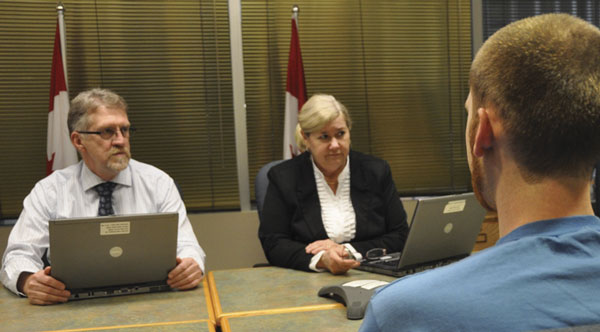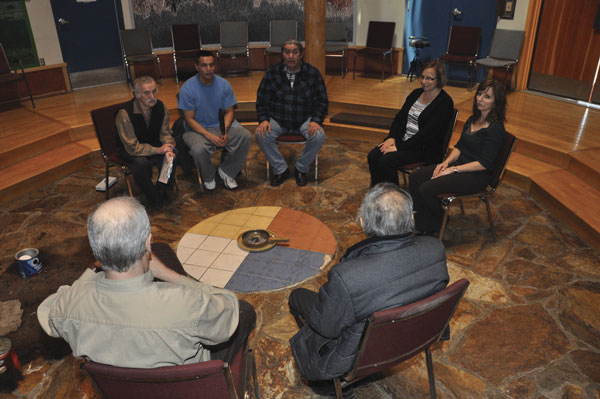// Interview: Jennifer Oades
Chairperson of the Parole Board of Canada
JT: What is the Parole Board of Canada?
JO: The Parole Board of Canada (PBC or the Board) is an agency within the Public Safety and Emergency Preparedness Portfolio. It is an independent administrative tribunal that has exclusive authority and absolute discretion under the Corrections and Conditional Release Act to grant, deny, cancel, terminate or revoke day parole and full parole, and authorise or approve temporary absences.
The PBC can also, on referral, terminate or revoke statutory release. Furthermore, the PBC is responsible for imposing, modifying or removing release conditions on temporary absences, day parole, full parole, statutory release, and long-term supervision. The PBC may also order, on referral by the Correctional Service of Canada (CSC), certain offenders to be held in prison until the end of their sentence. This is called detention.
In addition, the PBC makes conditional release decisions for offenders in provinces and territories that do not have their own parole boards (only Ontario and Quebec have their own parole boards). As part of the Canadian criminal justice system, the PBC makes independent, quality conditional release and record suspension decisions and clemency recommendations, in an open and accountable manner, while respecting the rights and dignity of both offenders and victims, in accordance with its statutory responsibilities and authorities.
Moreover, the PBC is responsible for making decisions to order, refuse to order and revoke record suspensions (also referred to as pardons) under the Criminal Records Act and the Criminal Code. It also makes recommendations for the exercise of clemency through the Royal Prerogative of Mercy.
JT: How does the PBC work and how does it promote the social reintegration of offenders?
JO: Our mandate is all about contributing to public safety and we do this by making quality decisions on the timing and the conditions of an offender’s release. The vast majority of offenders are serving fixed sentences and will, therefore, return to our communities at some point in time.
Research shows that the best way to contribute to public safety is to have an offender released gradually into the community through various types of conditional releases – from temporary absences to day parole, to full parole – where they are under supervision so that the risk can be managed and they can have the support mechanisms to help them become law-abiding citizens and reintegrate successfully into their communities.
How conditional release decision-making works is that offenders, at a certain point in their sentence, are reviewed for parole (day or full, depending on their circumstances) – this can be as a result of a legislated review or by an application. Some reviews are by way of a paper decision, while some are done by way of a hearing. In the latter case, the offender’s case management team, in particular , the parole officer of CSC, which is the prison part of the criminal justice system, will present the case to the Board.
From there, the Board will ask the offender questions about the release plan, about what the offender has learned through the various programs they participated in, etc. If there are victims who have said they want to get involved in the review, they can; and they may also provide a written statement to the Board for consideration.
The Board’s final decisions take into consideration all the relevant and persuasive information – from what the judge’s reasons for sentencing were, whether programs were successfully completed, whether there have been psychological or psychiatric risk assessments, what the community thinks about that offender returning, whether there are support mechanisms available to the offender, and any victim input. The Board can also impose conditions on an offender’s release.
There are all sorts of special conditions that can be attached to the conditional release, such as to continue with their psychological counselling or to address substance abuse issues.
In the end, the protection of society is our paramount consideration, including whether the release of the offender would contribute to the protection of society by facilitating their reintegration into the community as a law-abiding citizen.
I think we all recognise that someone coming out at the very end of their sentence, free and clear, under no supervision, is really not in the best interest of public safety nor does it provide the necessary supports needed to successfully integrate someone back into society.

JT: Who are the Board members and what preparation and training do they have?
JO: Any Canadian citizen can apply to become a member of the Board. We don’t have a lot of really young members and that might be because the appointments are only for a set period of time, so most Board members are more at the end of their career or in their post-retirement.
We have Board members who have worked in the corrections system, and people who have worked in the criminal justice system, such as police officers and lawyers. There are also social workers, psychologists and people who have worked in the educational system.
In the final analysis, the Board is comprised of Canadians that reflect the diversity of Canadian communities. We provide extensive training to our Board members in not only our law but also on risk assessment, special vulnerable populations, mental health, Indigenous offenders, women offenders, and so on.
The training also entails observing hearings. It can take four to six months of training for Board members to be ready and confident in making the various types of decisions required by law.
JT: To what extent does the PBC cooperate with the correctional service and community organisations?
JO: We work in partnership with many organisations: obviously the Correctional Service of Canada (CSC) is our biggest partner; it’s who we work with most closely. Even though there are two other parole boards in the country – Ontario has one and so does Quebec – for all the other provinces and territories, it’s the PBC who makes decisions related to provincial offenders (those serving less than two years).
We have regular meetings with the CSC on various issues of mutual interest and concern and have partnered on things such as the creation of a “Victims Portal” – a secure online portal that allows registered victims to access services and information which they are entitled to, under the law
. We also work closely with the Royal Canadian Mounted Police – our federal policing authority – because the Board is also responsible for pardons and record suspensions. And there are many non-governmental organisations such as the John Howard Society, the Elizabeth Fry Society, St. Leonard’s Society, the Salvation Army, victim groups, and Indigenous groups to name but a few.
When we’re making decisions about offenders, we want to know where offenders “are going”, what programs are being offered in the community, and what kind of support they have. It is important that we work with these organisations, both nationally and locally, to hear their concerns and to ensure our doors are open for opportunities to continually improve our decision-making.
JT: Some trends such as the fact that the vast majority of parole orders are successfully completed and that, over the past decade, the rate of violent conviction for offenders while under supervision has declined, are among the positive indicators of PBC’s performance. (Source: 2016 Corrections and Conditional Release Statistical Overview).
What are the results of PBC’s work that you are most proud of?
JO: I’m still relatively new here, so I’m not quite sure of all the things I’m proud of. [Laughs]. I’m sure there’s some things that I am going to miss but let me mention a few. Firstly, our results in terms of our conditional release success rates are quite outstanding: last year, 99% of day parole and 98% of full parole were successfully completed without reoffending. Now, some of these offenders could have been suspended for a period of time and then re-released – but without reoffending.
Secondly, the Board makes over 15,000 release decisions a year. Currently, the Parole Board of Canada has a shortage of Board members so their dedication and professionalism has to be acknowledged. We are working to increase our Board member complement to its normal number of approximately ninety members.
Thirdly, we have some amazing results given that we are a small organisation of 485 people. The staff of the Board provide superb support to Board members in the preparation of case files and at the hearings, and also to victims by helping them access the services and information that we are legally mandated to provide. Last year we had over 32,000 contacts with victims, a 10% increase from the previous year.
Victims are permitted to provide statements to the Board; that is to provide a written statement and to present it (read it) at hearings. Last year, there were 244 presentations of victim statements at 149 hearings. There are currently 8,300 registered victims to whom we provide ongoing information about an offender’s upcoming review.
Our success rates are quite outstanding: last year, 99% of day parole and 98% of full parole were successfully completed without reoffending.
JT: Are there any indicators that need improvement and/or challenges that you would like to see solved, and how are you addressing them?
JO: There are always improvements to be made. I’d just like to speak about two of them. The first is Indigenous offenders. This country has a shameful past in terms of what has happened with Indigenous people, and the resulting trends within the criminal justice system.
There is a disproportionate representation of Indigenous people in prison: although they make up less than 5% of the Canadian population, they represent 20% of the incarcerated population. And it’s worse for women: about 40% of the incarcerated women are Indigenous. This is a very challenging issue.
Government-wide there have been enormous efforts to address a number of issues impacting Indigenous peoples and there has been some progress made in the criminal justice system. For example, the PBC has introduced Elder-assisted hearings which provides a culturally appropriate environment and approach. Moreover, we have Community-assisted hearings, which are held in the community and follow an Elder-assisted format.

We ensure that Board members are provided with training to ensure that Aboriginal social history is taken into consideration in our decision-making and in how we interview Indigenous offenders. We’ve been training Board members recently on the fetal alcohol spectrum disorder (FASD). We need to take a different interview approach when addressing an offender who has FASD and we need to understand what community supports are there for them.
I have also just set up a new Chairperson’s Indigenous Committee that I will chair. I’ve invited a number of Indigenous individuals from some of our partner organisations and also from completely outside of the criminal justice system to try to inform me of things that I don’t know about and to “hold my feet to the fire” to continue to improve our response to Indigenous offenders. I will be listening a lot, over the next little while.
The other area where I feel we can make improvements is women offenders. It is the fastest growing group in the prison population. They do have unique needs, their pathway to crime is different. The research says that we should be doing things differently when it comes to hearings – other jurisdictions are already doing hearings quite differently for women than for men, and I support that.
About 90% of women have suffered trauma in some way whether sexual, physical, or psychological abuse, therefore we have to become more trauma and gender-informed in terms of how we conduct parole hearings for women. So, we’re going to look at this and see what more we should be doing.
Other jurisdictions are already doing hearings quite differently for women than for men, and I support that.
JT: This year marks the 20th anniversary of ICPA, an Association that you saw born and of which you were the first Executive Director.
How do you feel about being so involved in the founding of an international organisation and how does that experience help you in the present?
JO: I can’t believe 20 years have passed! I was invited to be the first Executive Director by a small group of people who really wanted to make a difference. I was so excited to be part of that. We started from nothing and we didn’t really know what we were doing, but we did it and got it started.
I was there for the first five years and saw it grow, but really it was the executive directors and the board members that came after me that have made ICPA into one of the more influential correctional associations in the world. I’m incredibly proud but humbled to have been a part of getting it up and going. I can’t say enough about how those five years affected me in terms of my understanding of corrections.
Most of us working in the criminal / corrections / conditional release field have common challenges. To get together and discuss those challenges and what people are doing about them is so helpful. You don’t have to reinvent the wheel because other people are going through, or have gone through, the same challenges.
Through the ICPA, I built a wonderful and very helpful network. I can still pick up the phone today and reach out to my network when I have a question about an issue.
And now that I’m here, as the Chairperson of the PBC, it’s really nice to know that those networks are still alive, and that people are still wanting to help each other. Learning about different systems and different approaches has been so enriching and has helped inform me in all my work.
//
Jennifer Oades was appointed Chairperson of the Parole Board of Canada in January 2018. She began her career with the Correctional Service of Canada (CSC) in 1991 where she has held numerous positions, including within community corrections. Mrs. Oades led the establishment of the ICPA, in 1998, where she served as Executive Director for five years. Upon returning to CSC, she continued her work within the policy and intergovernmental portfolios and served as the Director General of both the Strategic Policy and Intergovernmental Relations, the Learning and Development Branch and Deputy Commissioner for Women. She retired from CSC in 2014. Mrs. Oades holds a B.A. in Anthropology and Native Studies from Trent University.
Advertisement



